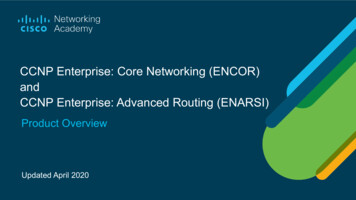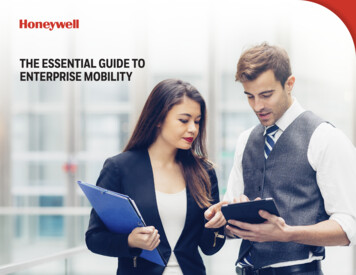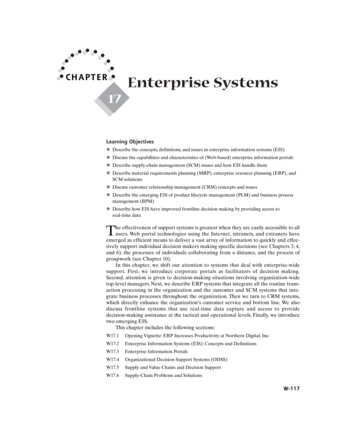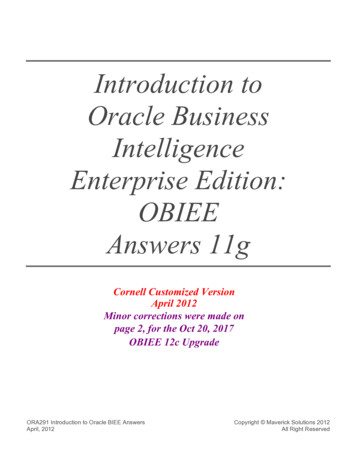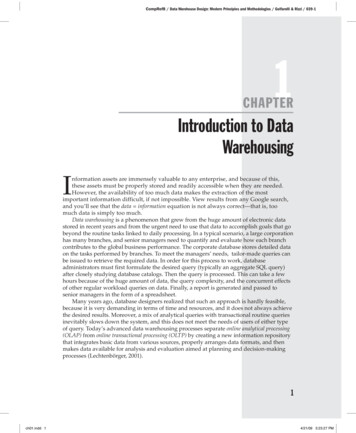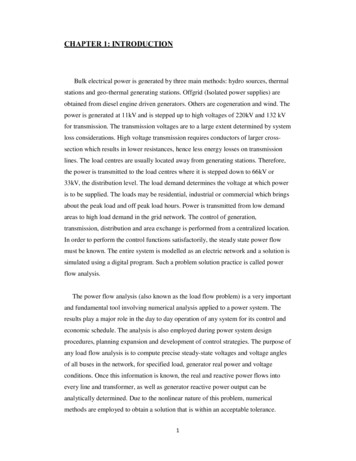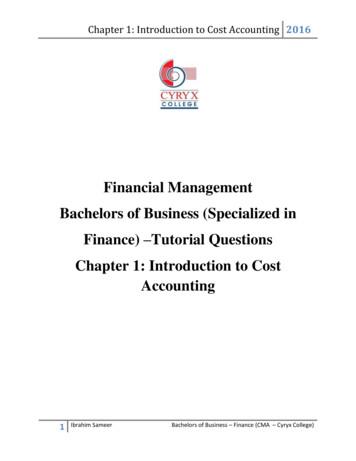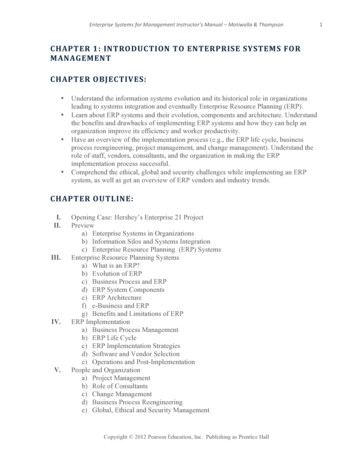
Transcription
R(OBJECTIVES:( Understand the information systems evolution and its historical role in organizationsleading to systems integration and eventually Enterprise Resource Planning (ERP).Learn about ERP systems and their evolution, components and architecture. Understandthe benefits and drawbacks of implementing ERP systems and how they can help anorganization improve its efficiency and worker productivity.Have an overview of the implementation process (e.g., the ERP life cycle, businessprocess reengineering, project management, and change management). Understand therole of staff, vendors, consultants, and the organization in making the ERPimplementation process successful.Comprehend the ethical, global and security challenges while implementing an ERPsystem, as well as get an overview of ERP vendors and industry trends.CHAPTER(OUTLINE:((I.II.III.IV.V.Opening Case: Hershey’s Enterprise 21 ProjectPreviewa) Enterprise Systems in Organizationsb) Information Silos and Systems Integrationc) Enterprise Resource Planning (ERP) SystemsEnterprise Resource Planning Systemsa) What is an ERP?b) Evolution of ERPc) Business Process and ERPd) ERP System Componentse) ERP Architecturef) e-Business and ERPg) Benefits and Limitations of ERPERP Implementationa) Business Process Managementb) ERP Life Cyclec) ERP Implementation Strategiesd) Software and Vendor Selectione) Operations and Post-ImplementationPeople and Organizationa) Project Managementb) Role of Consultantsc) Change Managementd) Business Process Reengineeringe) Global, Ethical and Security ManagementCopyright 2012 Pearson Education, Inc. Publishing as Prentice Hall1"
.XII.2"ERP Vendorsa) Key Vendorsb) Software Extensions and TrendsImplications for ManagementSummaryExercisesReview QuestionsDiscussion QuestionsReal World Case: Rolls Royce’s ERP ImplementationCHAPTER(OVERVIEW(This chapter provides a quick overview of the Enterprise Resource Planning (ERP)implementation process and the various topics covered in the remaining chapters of the book. Itbegins with an overview of the information systems field and defines ERP systems a fewdifferent ways, explaining their origin and evolution, and describes important components andbasic implementation options. In addition, it discusses the evolution and role of ERP in theorganizations and provides reasons for the popularity of ERP systems today.ERP systems are comprehensive applications that support and connect all aspects of anorganization’s business processes. When discussing business processes, one means suchdepartments as Accounting, Human Resources, Marketing, Purchasing, Manufacturing, etc. ERPsystems appeared in the 1990s as a way to provide accessibility, flexibility and consistencyacross all the major business functions, unlike its predecessors. Organizations that use ERPsystems have a better chance of sustaining competitive advantage in an ever-changing businessenvironment.The evolution of ERP started during the early 1990s after decades of using silo-basedinformation systems within business organizations. ERP is a software-based system that isresponsible for making information, reporting and functions widely available and centrallylocated within business organizations. In addition, the chapter continues to explain that ERPimplementation is not as easy as selecting and installing packaged software. The openingHershey case shows how a business went about the process the wrong way, and then correctedtheir mistakes the second time around. Hershey went live with their ERP implementation via the“Big Bang” method. Their initial problem was trying to implement too much, too fast. The caseprovides a good example of what to avoid.The five important components have to work together in order to create an ERP system.These components are: hardware, software, information, processes and people. Hardwareconsists of the physical equipment such as servers and peripherals. Software is the operatingsystem and/or database that the company or specific department uses. Examples of softwaretoday are Windows XP or Win 7. The information component is basically the data that is inputto the system by internal or external organizational resources. Processes consist of policies andprocedures that create the ways of conducting their business. The people of an ERP system arethe end-users and IT staff. End-users can be anyone from the employees to the suppliers of acompany.Another interesting aspect of ERP systems covered in this chapter is how they areimplemented in organization. Just like homes and large scale buildings, ERP systems have anarchitecture that the implementers must follow. Most of the time, a vendor is the one whoCopyright 2012 Pearson Education, Inc. Publishing as Prentice Hall
anual)–)Motiwalla)&)Thompson)3"creates the ERP architecture when an organization wishes to purchase outside the company. Thetwo types of architecture for an ERP System are logical and physical. Logical architecturesupports the needs of the end-users while physical architecture focuses on the efficiency of theactual ERP system. With logical ERP architecture, one must carefully examine what will makeup the layers, or tiers, in the blueprint.The different facets and features of an ERP system are explained throughout much of thechapter. Vanilla and chocolate architectures are explained in terms of their strengths andweaknesses. Package-driven (vanilla) ERP architectures are “off-the-shelf” implementations thatare generally much quicker to get up and running. Chocolate architectures are customizedoptions. Both architectures have their ups and downs. Vanilla implementations are quicker andless expensive; yet do not fully conform to the organization’s business procedures. Chocolatearchitectures take more time and money to configure, and may be more difficult to upgrade; butthey can result in a more ideal ERP system for the organization.Implementation strategies and the product life cycle are discussed. Both sections stressthe importance of taking it slow during this process. It is important to stay on track and followthe initial implementation plan through completion without getting bogged down by minor issuesor changes. Preparing for implementation is one of the most crucial times for an organizationwhen replacing their current system with a new ERP system. It is important that the organizationcreate an implementation committee in order to communicate necessary changes. Thesemembers should be knowledgeable enough to understand and plan for the implementationprocess itself. Another key decision a company must settle on is whether or not they shouldchange their business processes to fit the ERP system. If they decide to do so, this is known as“vanilla implementation.” It minimally modifies the ERP system that is purchased from thechosen vendor. This implementation committee needs to also understand the ERP life cycle andmethodology during this process. With a well-defined methodology, a company is able to takeone step at a time, define objectives, and plan a budget for the ERP implementation.The following sections deal with vendor selection, “going live”, and postimplementation. The chapter gives good advice about what criteria should be considered whentrying to decide upon a vendor. After a vendor is chosen and testing has been completed, it istime to “go live” with the software. This section warns that this can be the riskiest stage, and alsoprovides examples of implementation disasters. Guidelines and tips for maintaining the systemafter the “go live” stage are also discussed.Beyond the architecture and implementation process, this chapter compares thetechnologies of e-Business and ERP. During the 1990’s, there was speculation that e-Businessand ERP would compete as technologies. However, the technologies have developed more, andnow work together to provide a wider range of business support. Also, the Microsoft examplepresented in the middle of the chapter exemplifies the optimal outcome of a successful ERPimplementation. Microsoft utilized the ERP vendor SAP to restructure its systems whichresulted in annual savings of eighteen million dollars, and a greatly improved information systemwith significantly decreased data redundancies.Towards the end of the chapter is an exploration of business process management and thepeople involvement during the implementation of ERP systems. Process change and people arethe most important factors for success. There is advice on choosing project managers andvendors, how to deal with change management, and finally, some of the key vendors on themarket. Most organizations purchase ERP systems through outside vendors such as Oracle orSAP. Vendors need to fulfill certain criteria of a company in order to be considered. ProjectCopyright 2012 Pearson Education, Inc. Publishing as Prentice Hall
anual)–)Motiwalla)&)Thompson)4"management and change management help create trust among the people involved in overseeingthe new ERP system, and closely monitor objectives of the implementation plan.The chapter ends with some implications for management in the ERP process. In sum, itgives a good step-by-step introduction to key information about ERP. It explains itsdevelopment, components, limitations, successes, risks and the process of establishing animplementation plan. It also gives the reader so much information about ERP systems that it actsas a summary for the rest of the book in itself. Additionally, tables in the summary sectionprovide a quick overview of benefits and limitations of ERP systems.ADDITIONAL(RELATED(INFORMATION(1. http://en.wikipedia.org/wiki/Enterprise resource planning2. oc/jsp/indseg/solutionarea/erp/index.jsp3. ry/496923.html4. http://olcsoft.com/top%20ERP%20vendors.htm – an exhaustive list of current ERPvendors5. http://en.wikipedia.org/wiki/Information systems – review of information systemsincluding history of, and applications6. http://erpwire.com general information about ERP and ERP vendors7. http://media.wiley.com/product data/excerpt/80/04712351/0471235180.pdf–achapter discussing ERP implementation in detail8. http://www.dba-oracle.com/art insider erp.htm – information about the vendorselection process9. http://www.cio.com/topic/1463/ERP – a good general resource for ERP questions andproduct ONS(1. How is the role of an ERP system different from traditional TPS, MIS, DSS andothers? Can an ERP system support all levels of management?An ERP system is different in that it brings all departments within an organizationtogether. It seeks to unite all departments, open communication and consolidate alldatabases into one accessible database. Previous information system models did not havethis focus or ability. ERP can support all levels of management, because it allows eachlevel to utilize information in a customized manner. Upper-level management can utilizereports suited to their positions as overseers, while operational management can utilizedetailed reports for their specific functions.2. Discuss the evolution of information systems in an organization. How can the use ofERP systems remove information or functional silos in organizations?Most organizations start out with basic information systems, and build from a standardplatform as they grow in size and needs. As their needs and market positions change,Copyright 2012 Pearson Education, Inc. Publishing as Prentice Hall
anual)–)Motiwalla)&)Thompson)5"they may find that they need an information system that can better aid their businesspractices. At some point they may decide to implement an ERP system from a vendorsuch as SAP, Peoplesoft or Oracle. When a company implements the ERP system, iteliminates the divisions or silos that naturally occur in the organization.3. Among all the ERP components listed in the chapter, which component is mostcritical in the implementation process and why?People, including all levels of employees and management, are the ones that will use andbe affected by the ERP system. It is critical that all are on board with the decisions thatare made, and willing to give feedback during all stages. An ERP system cannot besuccessful unless the people of an organization are willing to accept the possibility ofchange and business reform.4. Discuss the role of ERP in organizations. Are ERP tools used for business processreengineering (BPR) or does BPR occur due to ERP implementation?Implementing an ERP often means BPR will take place. Organizations should realizethat the purchase of ERP software requires some changes to business practices in order torun smoothly. Vanilla implementations will require the most amount of BPR, whilechocolate implementations (although more difficult to get up and running) will likelyrequire less BPR in the long run.5. Why is the design and selection of ERP architecture crucial for the implementationproject? What are the long-term implications of selecting a wrong architecture?A business organization must start with the correct architecture to meet their needs for anew ERP system. If they choose a chocolate implementation, but really only need apackage-driven vanilla architecture, they may waste large sums of company money andtime. Chocolate implementations can be very time consuming and costly. Also, vanillaimplementation architectures are toted as being the best option from vendors, as theyutilize the “best business practices” across various industries.6. Discuss the criteria for selecting ERP
ERP systems are comprehensive applications that support and connect all aspects of an organization’s business processes. When discussing business processes, one means such departments as Accounting, Human Resources, Marketing, Purchasing, Manufacturing, etc. ERP systems appeared in the 1990s as a way to provide accessibility, flexibility and consistency
